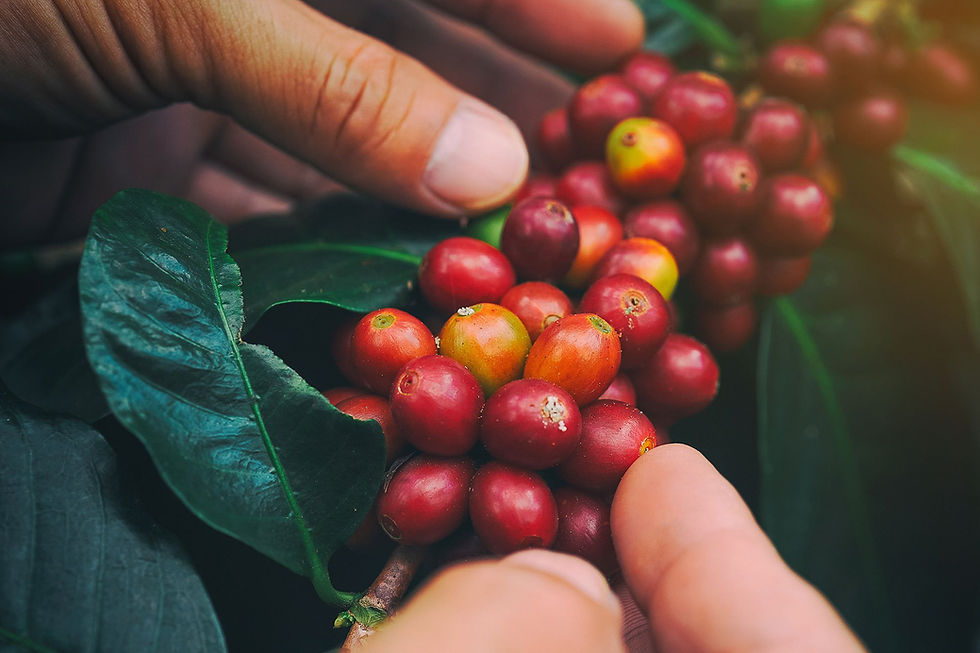DEFECTS IN GREEN COFFEE BEANS
- IO Coffee

- Mar 20, 2023
- 4 min read
Updated: Apr 14, 2023
There is nothing perfect, and green coffee beans are no exception. Despite optimizing the quality of farming, harvesting, and improving production equipment, it is inevitable that defect beans - flawed beans will appear in bags of green coffee.
These defects will directly reduce the quality of the finished coffee you hold in your hand. In addition to unpleasant bitter tastes, sometimes unpleasant smells can also appear.

Common defects in green coffee beans. Source: Caffe Nero
Therefore, for Specialty Coffee producers, there is always a stage of inspection and sorting out defects before sending the product to customers. This stage can be done by machine or by hand.
In today's article, Ro will share with you all the details about these defects and how they negatively affect our coffee.
What is coffee defects?
Coffee defects are a type of coffee that exhibits unnatural characteristics and poor quality due to errors that occurred during cultivation, harvesting, processing stages. When referring to the term "Defect" the Specialty Coffee Association (SCA) also includes unwanted foreign objects that may appear in coffee, such as rocks, branchs, and insects. These defects can significantly impact the quality and taste of the final coffee product.
SCA has published a set of documents on these coffee defects to unify and systematize the standards for screening and evaluating the quality of Specialty Coffee.
Currently, SCA has only released publications dedicated to Arabica coffee beans, without official guidelines applying to Robusta or Liberica. However, currently, producers or roasters implicitly understand and use the same standards for all coffee beans they produce.

Source: SCA
Common coffee defects

Mold: Coffee beans exposed to excessive moisture during the drying, roasting, or storage process can create conditions for mold growth, leading to unpleasant tastes such as moldy and musty flavors in coffee. These types of molds can develop and spread to other beans.
Insect-damaged: are coffee beans that have bite or boreholes from insect infestation. If there are many of these beans in your coffee batch, they will leave a sour or bitter taste, pungent and unpleasant flavor.
Full Black/Full Sour: These defects occur when coffee cherries are picked either unripe or overripe. These beans are the result of over-fermentation inside the fruit before harvesting and processing, resulting in a strong alcoholic fermentation flavor and a heavy, sour vinegar taste in the coffee.
Broken/chipped/cut: is a defect that occurs during processing, specifically during the hulling process. This leads to the cut area being more susceptible to oxidation, which can result in a decrease in quality. In addition, having too many beans with this defect can cause an uneven roast, as the broken beans are more likely to become charred.

Quakers: These are the immature, unevenly ripe, or undernourished seeds of coffee fruits during their development. During roasting, these seeds will not have enough chemical compounds to participate in the mailard process, resulting in a lighter color compared to other beans in the same batch, and your coffee will lack sweetness and flavors if it contains many quakers.

Shell: This is the outer part of an extraneous object in the shape of an elephant ear or seashell. This is the result of a mutation in the coffee bean. This type of bean does not actually have a direct impact on the flavor, however, it has a thin and flat structure, leading it to be the first beans to burn when roasting coffee.
Stones, dried pods and branchs: These are foreign objects that may appear in your coffee if the previous processing steps did not meet the standards. Stones can be the cause of damage to machinery during the coffee roasting and grinding process; broken coffee husks can easily ignite and cause smoke and burnt smell in the roasting chamber; and finally, twigs and branches can bring unpleasant taste or sensation to your coffee cup.
The meaning of coffee defects to the production process
Basically, the appearance of coffee defects indicate that the cultivation or processing process has some flaws and is not optimal. Based on the characteristics of each type of defects, the producer will have different methods to overcome them.
To farmers and producers
To obtain good quality green bean products that meet high coffee quality standards and minimize defects, both farmers and producers always seek ways to overcome and improve.
Equipping and updating professional knowledge as well as building a model with a process that fully meets quality control criteria will require significant investment costs.

It takes a lot of love, knowledge and expense to make a good cup of coffee. Source: Vietnam Investment Review
For farmers, it is the cost of soil improvement, fertilization, planned cultivation, or for producers, it is investment in facilities, labor, etc. Therefore, high-quality coffee products on the market will have a higher price than the average.
To roasters
According to many subjective opinions, roasters are very limited in working with producers who have too many defective coffee beans in their coffee lots.

After receiving green coffee beans from suppliers, roastery workers always manually sort their coffee to pick out coffee defects, which can occur before or after roasting. The more coffee defects there are, the longer the roaster spends on sorting.
Therefore, they will prioritize working with reputable producers and suppliers who provide better quality coffee. At the same time, well-processed coffee will ensure the quality of the coffee during long-term preservation.
Reference:





















Comments